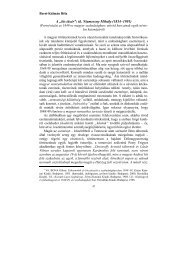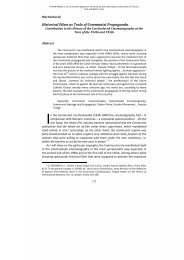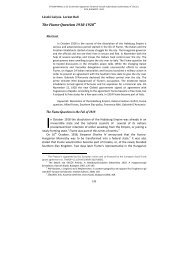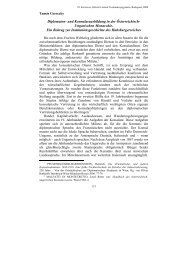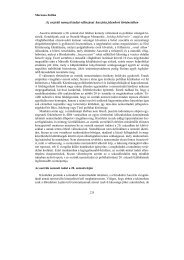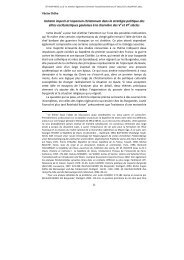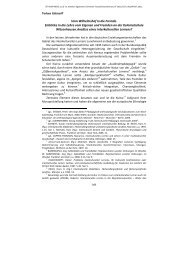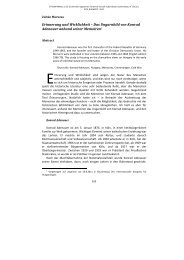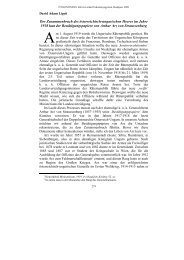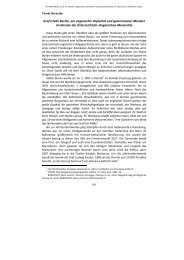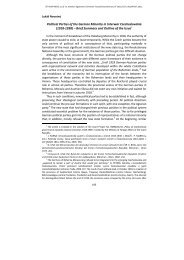The Molotov-Ribbentrop Pact - ELTE BTK Történelem Szakos Portál
The Molotov-Ribbentrop Pact - ELTE BTK Történelem Szakos Portál
The Molotov-Ribbentrop Pact - ELTE BTK Történelem Szakos Portál
Create successful ePaper yourself
Turn your PDF publications into a flip-book with our unique Google optimized e-Paper software.
started when the Germans entered a town or city, triggered by a vacuum of<br />
power in the short period between the abandonment of these towns by the Red<br />
Army and the arrival of German units. In other cases, Germans took advantage<br />
of an already existing mood to start pogroms or they initiated such anti-Semitic<br />
riots. 39 Although he could not find any written directive, Dieter Pohl assumes<br />
that these events had been coordinated because they took place in such similar<br />
forms and in such parallel ways everywhere. 40<br />
Background to these riots were the experiences of local people during and<br />
with the Soviet occupation as well as historical relations of the region‘s<br />
nationalities as shown above. After their torturers had left, people were looking<br />
for someone they could hold responsible for everything they had to endure and<br />
they accepted whomever they could find, which in these cases most often were<br />
their Jewish neighbours who stayed behind and who were associated with the<br />
occupational regime. 41 As I already showed, the Jewish percentage within the<br />
administration was not higher than that of any of the other nationalities, but<br />
people felt it was. Jews were generally associated with the Soviets. 42<br />
<strong>The</strong> Bogdan-Musial-controversy<br />
A few years ago, the historian Bogdan Musial made a case, when he<br />
claimed that the NKVD‘s crimes where the one initial that caused the violent<br />
excesses against Jews. When the local people discovered the thousands of<br />
bodies the NKVD had killed only hours before they fled, the people, according<br />
to Musial, had wished to take revenge. - A good description of these atrocities<br />
may be found in Richard Overy‘s book. 43<br />
Musial is eager to explain the riots not as actions triggered by the soon-to-be<br />
German arrival, but as a sole reaction to these discoveries. <strong>The</strong> locals had<br />
POHL, Dieter: Nationalsozialistische Judenverfolgung in Ostgalizien 1941-1944 - Organisation und<br />
Durchführung eines staatlichen Massenverbrechens. München, 1996. 60. An.107 lists, with regard to<br />
Weiss, pogroms in 58 towns in the Western Ukraine, as well as in various villages.<br />
39 For example the pogrom in Lemberg (Lviv) had been initiated by Wehrmacht units, see POHL,<br />
Dieter: Schauplatz Ukraine - Der Massenmord an den Juden im Militärverwaltungsgebiet und im<br />
Reichskommissariat 1941-1943. In: FREI, Norbert et al. (Ed.): Ausbeutung, Vernichtung, Öffentlichkeit<br />
- Neue Studien zur nationalsozialistischen Lagerpolitik. München, 2000. 139.<br />
40 POHL, Dieter: Nationalsozialistische Judenverfolgung in Ostgalizien 1941-1944 -<br />
Organisation und Durchführung eines staatlichen Massenverbrechens. München, 1996. 57. See<br />
also HILBERG, Raul: Täter, Opfer, Zuschauer - Die Vernichtung der Juden 1933-1945, Frankfurt<br />
am Main, 1992. 220.<br />
41 MUSIAL, Bogdan: „Konterrevolutionäre Elemente sind zu erschießen” - Die Brutalisierung<br />
des deutsch-sowjetischen Krieges im Sommer 1941. Berlin 2001. 76.<br />
42 POHL, Dieter: Ukrainische Hilfskräfte beim Mord an den Juden. In: PAUL, Gerhard (Ed.): Die<br />
Täter der Shoah - Fanatische Nationalsozialisten oder ganz normale Deutsche?, Göttingen, 2002. 211.<br />
43 OVERY, Richard: Russlands Krieg-1941-1945, Reinbek bei Hamburg, 2003. 185.<br />
BERKHOFF, Karel C.: Harvest of Despair-Life and death in Ukraine under Nazi rule.<br />
Cambridge, 2004. 56.<br />
177



